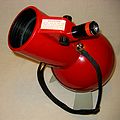
Astroscan
Encyclopedia

Edmund Scientific Corporation
Edmund Scientific Corporation was a company based in Barrington, New Jersey that specialized in supplying surplus optics and other items via its mail order catalog and Factory Store. During four decades from the 1940s to the 1970s Edmund Scientific was virtually unique in its offerings to...
. It was designed by Norman Sperling
Norman Sperling
Norman Sperling is an author, editor, publisher, teacher, and telescope designer living in San Mateo, California.Sperling received a BA from Michigan State University after graduating from Montgomery Blair High School in Silver Spring, Maryland. He followed that with an MA in History of Science...
and Mike Simmons to be used as an introductory telescope. Rather than using a more traditional equatorial
Equatorial mount
An equatorial mount is a mount for instruments that follows the rotation of the sky by having one rotational axis parallel to the Earth's axis of rotation. This type of mount is used for astronomical telescopes and cameras...
or altazimuth mount
Altazimuth mount
An altazimuth or alt-azimuth mount is a simple two-axis mount for supporting and rotating an instrument about two mutually perpendicular axes; one vertical and the other horizontal. Rotation about the vertical axis varies the azimuth of the pointing direction of the instrument...
the Astroscan features a spherical housing around the primary reflector which sits in a cast aluminum cradle. The design is durable and allows for simple operation by novice amateur astronomers; it won an Industrial Design Award in 1976. The telescope body is made from high impact ABS
Acrylonitrile butadiene styrene
Acrylonitrile butadiene styrene is a common thermoplastic. Its melting point is approximately 105 °C ....
and is equipped with a carrying strap to aid portability.
Optical design
The Astroscan is a simple Newtonian reflector. It has a 4⅛" clear-inch (105mm) diameter f/4.2 aluminized and overcoated borosilicate glassBorosilicate glass
Borosilicate glass is a type of glass with the main glass-forming constituents silica and boron oxide. Borosilicate glasses are known for having very low coefficients of thermal expansion , making them resistant to thermal shock, more so than any other common glass...
parabolic
Parabolic reflector
A parabolic reflector is a reflective device used to collect or project energy such as light, sound, or radio waves. Its shape is that of a circular paraboloid, that is, the surface generated by a parabola revolving around its axis...
primary mirror
Primary mirror
A primary mirror is the principal light-gathering surface of a reflecting telescope.-Description:The primary mirror of a reflecting telescope is a spherical or parabolic shaped disks of polished reflective metal , or in later telescopes, glass or other material coated with a reflective layer...
with a focal length
Focal length
The focal length of an optical system is a measure of how strongly the system converges or diverges light. For an optical system in air, it is the distance over which initially collimated rays are brought to a focus...
of 17½ inches (445mm). Because it is targeted at the novice market the telescope does have its limitations: the general design is for low power hand-held or wide-angle work, the short f/4 focal ratio does not allow for high magnification without the image degrading, and the primary mirror is factory aligned with no provisions for adjustment. The telescope's secondary mirror
Secondary mirror
A secondary mirror is the second deflecting or focusing mirror element in a reflecting telescope. Light gathered by the primary mirror is directed towards a focal point typically past the location of the secondary. Secondary mirrors in the form of an optically flat diagonal mirror are used to...
is mounted on an optical window at the front of the tube giving it the appearance of a catadioptric telescope, however the window is flat and does not contribute to the focal properties of the telescope. The Astroscan comes with a 15 mm and a 28 mm focal length eyepiece
Eyepiece
An eyepiece, or ocular lens, is a type of lens that is attached to a variety of optical devices such as telescopes and microscopes. It is so named because it is usually the lens that is closest to the eye when someone looks through the device. The objective lens or mirror collects light and brings...
s giving it a magnification of 30X and 16X respectively, with a 3.0°
Degree (angle)
A degree , usually denoted by ° , is a measurement of plane angle, representing 1⁄360 of a full rotation; one degree is equivalent to π/180 radians...
field of view
Field of view
The field of view is the extent of the observable world that is seen at any given moment....
using the 28 mm eyepiece, and a 1.6°
Degree (angle)
A degree , usually denoted by ° , is a measurement of plane angle, representing 1⁄360 of a full rotation; one degree is equivalent to π/180 radians...
with the 15 mm.

